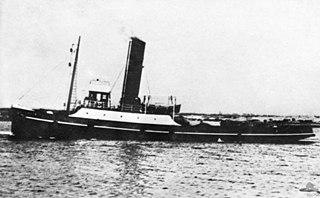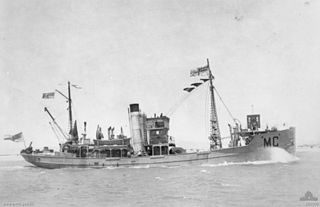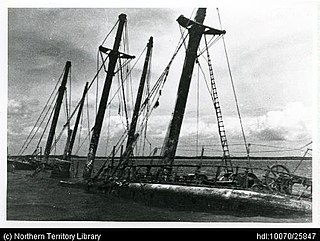
HMAS Doomba was a Royal Australian Navy (RAN) warship of World War II. Built for the Royal Navy around the end of World War I as the Hunt-class minesweeper HMS Wexford, the ship only saw two years of service before she was decommissioned in 1921 and sold to the Doomba Shipping Company. The vessel was renamed SS Doomba, converted into a passenger ship, and operated in the waters around Brisbane until 1939, when she was requisitioned by the RAN for wartime service. Serving first as an auxiliary minehunter, then an auxiliary anti-submarine vessel, HMAS Doomba was purchased outright by the RAN in 1940, and served until early 1946, when she was sold and converted into a linseed oil lighter. Doomba was scuttled off Dee Why, New South Wales in 1976.
Ravelston was an 2,808 GRT cargo ship which was built in 1906 for the Ravelston Steamship Co Ltd. She was requisitioned by the Ministry of War Transport (MoWT) in 1941 and renamed Empire Bond. In 1946 she was sold and renamed Prenton. Following a grounding in 1949, she was declared a constructive total loss, but was sold and repaired, returning to service as Agios Dionysissios. In 1951 she was renamed Sandenis and then San Denis, serving until she was scrapped in 1959.

HMAS Bonthorpe (TR-8) was an auxiliary minesweeper operated by the Royal Australian Navy during World War II. She was launched in 1917 by Collingwood Shipbuilding Company at Collingwood, Ontario, Canada. Bonthorpe was owned and operated by Albany Tug Company. On 5 February 1940, Bonthorpe was requisitioned by the RAN for use as an auxiliary. She was decommissioned on 17 February 1945 and was reconverted to a trawler before becoming stranded at Cairns Inlet, Queensland in 1959.

HMAS Durraween (F93) was an auxiliary minesweeper operated by the Royal Australian Navy (RAN) during World War II. The ship was built as a trawler by Collingwood Shipbuilding Company at Collingwood, Ontario, Canada, and launched in 1918 as Seville. The ship served briefly in the Royal Canadian Navy during the last months of World War I, before being laid up and sold to a British company. In 1928, she was sold to Sydney-based fishing company and operated in Australian waters until she was requisitioned by the RAN in mid-1940 for use as an auxiliary minesweeper during World War II. Durraween operated in the Bass Strait as part of Minesweeping Group 54, and was responsible for clearing mines laid by German merchant raiders, and then later operated around the Torres Strait. She was returned to civilian service after paying off in late 1945, and was broken up in 1952.
HMAS Goolgwai was an auxiliary minesweeper operated by the Royal Australian Navy (RAN) during World War II. She was launched in 1919 by Collingwood Shipbuilding Company at Collingwood, Ontario, Canada as Almeria. The ship operated in Australian waters from 1928, and was requisitioned by the RAN on 3 September 1939. She was returned to her owners in 1945 before being wrecked near Malabar, Sydney, on 29 May 1955.
HMAS Korowa was an auxiliary minesweeper operated by the Royal Australian Navy (RAN) during World War II. She was launched in 1919 by Cochrane and Sons Ltd at Selby as Edward McGuire. The ship operated in Australian waters from 1937, and was requisitioned by the RAN in September 1939. She was returned to her owners in 1945 before being scrapped in 1954.

HMAS Olive Cam was an auxiliary minesweeper operated by the Royal Australian Navy (RAN) during World War II. She was launched in 1920 by Cook, Welton & Gemmell at Beverley as Nodzu. The ship operated in Australian waters from 1929, and was requisitioned by the RAN on 3 September 1939. She was returned to her owners in 1946 before being wrecked near Green Cape Lighthouse, Eden, New South Wales on 2 November 1954 with the loss of three lives.
HMAS Kianga was an auxiliary minesweeper operated by the Royal Australian Navy (RAN) during the Second World War. She was launched in 1922 by R. J. Lucey at Narooma. The ship operated as a coastal cargo steamer and was requisitioned by the RAN in 1941. She was not returned to her owners and was scuttled off Sydney Heads.

HMAS Wato (W127) was a tug boat operated by the Royal Australian Navy (RAN) during World War II. During World War I she was operated by the Royal Navy in the Mediterranean Sea. She later operated as a tug boat for the Adelaide Steam Tug Company before being requisitioned by the RAN. She was scrapped in 1955.

HMAS Beryl II was an auxiliary minesweeper, later boom gate vessel, operated by the Royal Australian Navy (RAN) during World War II. She was launched in 1914 by Cochrane & Sons at Selby. The ship operated as a trawler and was requisitioned by the RAN in 1939. She was returned to her owners on 24 May 1946 and was later scrapped in 1955.

HMAS Mary Cam was an auxiliary minesweeper operated by the Royal Australian Navy (RAN) during World War II. She was launched in 1918 by Ritchie, Graham & Milne, Whiteinch at Glasgow as Joule. The ship operated in Australian waters from 1928, and was requisitioned by the RAN on 5 October 1939. She was returned to her owners after the war and was later scrapped in 1957.

HMAS Terka (FY.98) was an auxiliary minesweeper operated by the Royal Australian Navy (RAN) during World War II. The ship was launched as Sir Dudley de Chair in 1925 as one of the three ships used to supply the construction of the Sydney Harbour Bridge, and from 1928 operated by the Adelaide Steamship Company until she was requisitioned by the RAN in December 1940. She sank while at her moorings at Madang, New Guinea on 26 March 1945 and was abandoned.

HMAS Allenwood (FY18) was an auxiliary minesweeper operated by the Royal Australian Navy (RAN) during World War II. She was launched in 1920 by Ernst Wright at Tuncurry, New South Wales, Australia as Allenwood for Allen Taylor and Co. Ltd. The ship operated along the east coast of Australia, and was requisitioned by the RAN on 27 July 1941. She was returned to her owners in 1946 before being wrecked near Norah Head on 14 September 1951.
HMAS Medea was an auxiliary minesweeper of the Royal Australian Navy (RAN) between 1942 until 1946. Built in 1912 for the Ocean Steam Ship Co. she was sold to the Straits Steam Ship Co. in 1925. She was requisitioned by the Royal Navy in 1939 and converted into an auxiliary minesweeper and named HMS Circe. She was transferred to the Royal Australian Navy in 1942 and renamed HMAS Medea until she was returned to her owners in 1946. She was sold and was scuttled off Sydney on 20 January 1948.

HMAS Mercedes was an auxiliary minesweeper of the Royal Australian Navy (RAN) between 1942 until 1946. Built in 1913 for the Ocean Steam Ship Co. she was sold to the Straits Steam Ship Co. in 1925. She was requisitioned by the Royal Navy in 1939 and converted into an auxiliary minesweeper and named HMS Medusa. She was transferred to the Royal Australian Navy in 1942 and renamed HMAS Mercedes until she was returned to her owners in 1946. She was sold and was scuttled off Sydney on 23 January 1948.

Kelat was an 1894 gross ton iron hulled fully rigged three masted sailing ship built in Stockton-on-Tees, England in 1881. She was requisitioned by the Royal Australian Navy (RAN) in 1941 and sank as a result of damage suffered during the Japanese air raid on Darwin on 19 February 1942.

HMAS Mallina was a 3,213 GRT cargo ship built by Harland & Wolff, Belfast in 1909 as Mallina for the Australian United Steam Navigation Company for the Rockhampton to Sydney cargo route. She was requisitioned by the Royal Australian Navy in 1914, as a store carrier and collier. She was returned to her owners in 1915. She was sold in 1935 to Machida Shokai Kisen Kaisha, Japan and renamed Seiko Maru, before being sold to Kita Nippon Kisen Kaisha and renamed Siberia Maru No. 3, which was later shortened to Siberian Maru. While steaming in the Sulu Sea, Philippines on 24 September 1944, she was attacked by American aircraft of Task Force 38 and sunk with the loss of 158 of the 2,382 people on board.
HMAS Orara was a coastal passenger and cargo steamship that was built in Scotland in 1907 and sunk by a mine in China in 1950. She spent most of her career in the fleet of the North Coast Steam Navigation Company (NCSNC) of New South Wales. In the Second World War she was an auxiliary minesweeper and depot ship in the Royal Australian Navy.
HMAS Samuel Benbow was an auxiliary minesweeper operated by the Royal Australian Navy (RAN) during World War II. She was launched in 1918 by Hall, Russell & Company, Aberdeen. She was a Strath class trawler admiralty design. The ship operated in Australian waters from 1929, and was requisitioned by the RAN and commissioned on 5 September 1940. She was resold to her former owners after the war.

The Stone Fleet was the colloquial name for the small coastal ships that carried crushed-stone construction aggregate to Sydney from the Illawarra ports of Kiama and Shellharbour and the nearby ocean jetties at Bombo and Bass Point.













